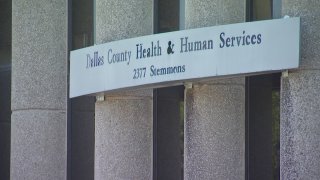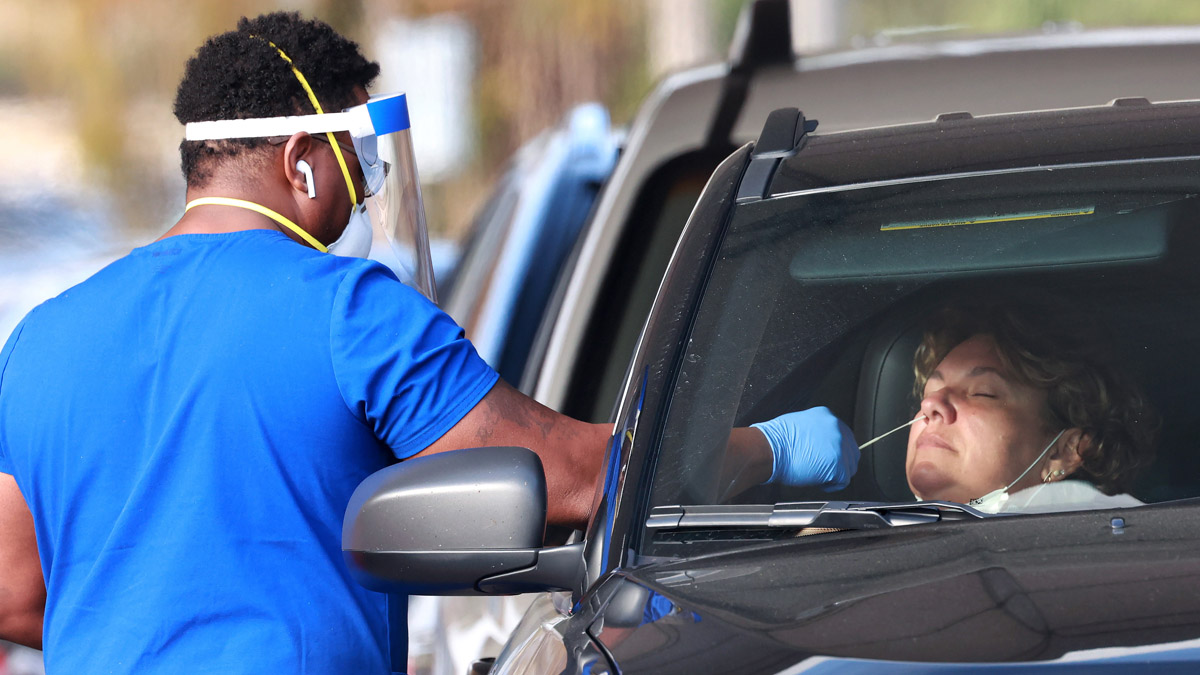
Health officials in Dallas County on Monday reported 730 new cases of COVID-19 as well as 31 more deaths attributed to the virus.
Of the cases reported Sunday, 645 were confirmed cases and 85 were probable cases, bringing the total number of confirmed cases in the county to 241,413 and the number of probable cases to 33,742. The total of confirmed and probable cases in the county is now 275,155.
Over the last seven reporting days, Dallas County officials have announced 6,893 new confirmed and probable cases of the virus -- the first time the seven-day total has dipped below 7,000 since Nov. 9. The county's seven-day average is 1,109 new cases per day.
In both Dallas County and TSA-E, the trauma service area that encompasses North Texas, hospitalizations for COVID-19 have been trending downward for more than two weeks.
Get DFW local news, weather forecasts and entertainment stories to your inbox. Sign up for NBC DFW newsletters.
Want to Get on a Vaccine Waitlist?
County health departments have launched waitlists for adults 16 years old and over.
You can register to recieve the vaccination in Collin, Dallas, Denton and Tarrant counties. Links are below:
Waitlist Links: Collin - Search Waitlist | Dallas | Denton | Tarrant
You do not need to be a resident of the county to register for a COVID-19 vaccine in that county -- registration is open to anyone in Texas. For those without internet access, Tarrant County is also taking registrations by phone at 817-248-6299. In Dallas County, call the DCHHS vaccine hotline at 1-855-IMMUNE9 (1-855-466-8639). In Denton County, call 940-349-2585.
For a more detailed breakdown of who is included in each priority group in Texas, see this page from the Texas DSHS.
With the 31 deaths added Monday, there have now been 2,653 deaths in the county attributed to COVID-19 since March 2020. The latest victims announced included people whose ages ranged from their 40s to their 90s.
- A man in his 40s who was a resident of the city of Grand Prairie. He had been critically ill in an area hospital and had underlying high-risk conditions.
- A woman in her 50s who was a resident of the city of Dallas. She had been critically ill in an area hospital and had underlying high-risk health conditions.
- A man in his 50s who was a resident of the city of Carrollton. He had been critically ill in an area hospital and had underlying high-risk health conditions.
- A man in his 50s who was a resident of the city of Garland. He had been critically ill in an area hospital and had underlying high-risk health conditions.
- A man in his 60s who was a resident of the city of Grand Prairie. He had been critically ill in an area hospital and had underlying high-risk health conditions.
- A man in his 60s who was a resident of the city of Farmers Branch. He had been critically ill in an area hospital and had underlying high-risk health conditions.
- A man in his 60s who was a resident of the city of Garland. He died in hospice and had underlying high-risk health conditions.
- A man in his 60s who was a resident of the city of Garland. He had been hospitalized and had underlying high-risk health conditions.
- A woman in her 60s who was a resident of the city of Richardson. She died in hospice and had underlying high-risk health conditions.
- A man in his 60s who was a resident of the city of Dallas. He had been critically ill in an area hospital and had underlying high-risk health conditions.
- A woman in her 70s who was a resident of the city of Dallas. She did in hospice and had underlying high-risk health conditions.
- A woman in her 70s who was a resident of the city of Dallas. She had been critically ill in an area hospital and did not have underlying high-risk health conditions.
- A woman in her 70s who was a resident of the city of Irving. She had been hospitalized and had underlying high-risk health conditions.
- A woman in her 70s who was a resident of the city of Dallas. She died in hospice and had underlying high-risk health conditions.
- A man in his 70s who was a resident of the city of Grand Prairie. He had been critically ill in an area hospital and did not have underlying high-risk health conditions.
- A man in his 70s who was a resident of the city of Dallas. He died at home.
- A man in his 70s who was a resident of the city of Garland. He had been hospitalized.
- A man in his 80s who was a resident of the city of Irving. He had been critically ill in an area hospital and had underlying high-risk health conditions.
- A man in his 80s who was a resident of the city of Dallas. He had been critically ill in an area hospital and had underlying high-risk health conditions.
- A man in his 80s who was a resident of the city of Desoto. He died in hospice and had underlying high-risk health conditions.
- A woman in her 80s who was a resident of the city of Dallas. She died in hospice and had underlying high-risk health conditions.
- A man in his 80s who was a resident of the city of Dallas. He had been critically ill and had underlying high-risk health conditions.
- A man in his 80s who was a resident of the city of Dallas. He had been critically ill and had underlying high-risk health conditions.
- A woman in her 80s who was a resident of a long-term care facility in the city of Garland. She died in the facility.
- A woman in her 80s who was a resident of the city of Grand Prairie. She died at home and had underlying high-risk health conditions.
- A woman in her 90s who was a resident of a long-term care facility in the city of Carrollton. She died in the facility.
- A woman in her 90s who was a resident of a long-term care facility in the city of Irving. She died in the facility.
- A woman in her 90s who was a resident of the city of Dallas. She had been critically ill in an area hospital and had underlying high-risk health conditions.
- A woman in her 90s who was a resident of a long-term care facility in the city of Irving. She died in the facility.
- A man in his 90s who was a resident of a long-term care facility in the city of Dallas. He had been hospitalized and had underlying high-risk health conditions.
- A man in his 90s who was a resident of a long-term care facility in the city of Dallas. He died in hospice and had underlying high-risk health conditions.
Last week, COVID-19 became the second-leading cause of death in Dallas County over the last 11 months, surpassing cancer, according to data from the Centers for Disease Control and Prevention and Dallas County Health and Human Services. Only heart disease has killed more people in Dallas County since March 19, 2020.
The Texas Department of State Health Services lists an estimated 248,883 recoveries for Dallas County as of Monday.
COVID-19 Latest
COVID-19 VACCINE EFFORTS
Dallas County currently operates a large-scale vaccination hub at Fair Park where they can vaccinate up to 2,000 people per day. The vaccination center does not accept walk-ups and you must have an appointment to get vaccinated. Register for an appointment at the link below.
The county has administered 43,823 first doses of the COVID-19 vaccine at the Fair Park site since Jan. 11.
The Fair Park vaccine hub is closed through Wednesday due to inclement weather. The winter weather may necessitate further closures.
Last week, FEMA announced the Fair Park location, along with AT&T Stadium in Arlington, would soon be mass vaccination hubs where more than 10,000 people per day could receive the vaccine. Those hubs are expected to be open by Feb. 24.
The judge reiterated that those who have received their first shot of the vaccine do not need to make an appointment for their second dose -- the date of the second appointment, he said, is on the back of the vaccination card received when the first dose was administered.
COVID-19 Vaccines
In Texas, the COVID-19 vaccines are currently available to anyone over the age of 5. The vaccines are still not approved for children younger than 5 however -- those trials are ongoing.
Once vaccinated, people who received either the Moderna or Pfizer vaccines are expected to get some level of protection within a couple of weeks after the first shot, but full protection may not happen until a couple of weeks after the second shot. For those who receive the Johnson & Johnson vaccine -- there is only one shot needed.
As of Jan. 3, 2022, it is also recommended those who are age 12 and up and who have been fully vaccinated receive a booster as early as five months after their last dose, for a total of three shots. The vaccine made by Pfizer and its partner BioNTech is the only U.S. option for children of any age.
As for even younger children, kid-size doses for 5- to 11-year-olds rolled out in November and experts said healthy youngsters should be protected after their second dose for a while. But the FDA also said on Jan. 3, 2022, that if children that young have severely weakened immune systems, they will be allowed a third dose 28 days after their second. That’s the same third-dose timing already recommended for immune-compromised teens and adults.
Pfizer and Moderna are studying their vaccines, in even smaller doses, for children younger than 5.
Even when fully vaccinated, it's still possible to become infected by the virus since none of the vaccines offer 100% protection from infection. With that in mind, even if you've been vaccinated it's still a good idea to wear a mask and keep some separation between strangers or those whose vaccination status is unclear.
Texas COVID-19 Vaccine Distribution
Data from the Texas Department of State Health Services shows where COVID-19 vaccines have been sent around the state. Click on a marker to find out information about each location. Use the "plus" and "minus" signs below to zoom in and out of the map.
From the Texas DSHS: Availability of COVID-19 vaccines lilsted on this map are based on shipping information and reporting to the DSHS directly by facilities. Please contact providers in advance to confirm vaccination location and hours, that they have vaccine on hand and that you are eligible for vaccination at that site. Not all providers are vaccinating the public or people in all priority groups. Vaccine is available at no charge, regardless of insurance status.


